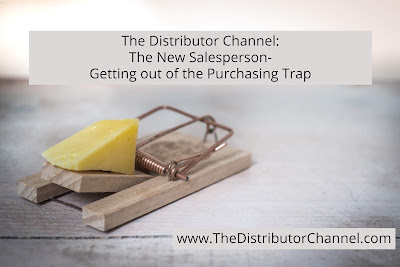The New Salesperson - Getting out of the Purchasing Trap
 You’re a new salesperson. You’re on the hunt for potential customers. And… it’s a struggle to find people willing to accept an appointment with you. Since you either found the name off the internet or asked someone “Who at your company buys left-handed widgets?” and ended up with a name, you find yourself face to face with a denizen of the purchasing department.
You’re a new salesperson. You’re on the hunt for potential customers. And… it’s a struggle to find people willing to accept an appointment with you. Since you either found the name off the internet or asked someone “Who at your company buys left-handed widgets?” and ended up with a name, you find yourself face to face with a denizen of the purchasing department.Purchasing departments come in many sizes, shapes and flavors. Other potential titles might include procurement, sourcing, supplier relationship management, and supply chain management. But make no mistake, these are purchasing people. Back in 2014, I received a great deal of flack for making/publishing this comment (and quoting myself):
“Imagine an epic battle. Conjure up a vision of cloven-hooved archfiends dashing the lifeblood of our economy. Think about an ever-escalating conflict with carnage scattered back to the 1970s. Visualize a place where one side knowingly operates under false assumptions and poorly conceived ideas skew the direction of whole industries.
Am I suffering from a persecution complex? Have I lost my mind? I don’t think so. What’s more, I am about to present some scholarly evidence to support my claim.
The claim: Commonly used purchasing practices cause companies to make bad buying decisions.
There are tons of articles pointing to the price being about number 5 or 6 on most customers’ list of priorities. Purchasing agents will wave this stuff around like Old Glory, but I have never bought into the story. Despite all the propaganda to the contrary, experienced salespeople testify; when procurement guys make buying decisions, price is at the top of their list.”
Read the full article here.
Purchasing departments are not a great use of your time
With this expectation and many will disagree, allow me to elaborate. Unless you are selling a pure commodity product, purchasing people do not “actively” make buying decisions on your products. This sounds strange because they ultimately provide you with the order, but only if your price is low. Here’s how it works. Someone else sets the specification, determines if your product meets said specification and passes the word on to the purchasing guy to place the order. The purchasing professional then determines who can source the product for the lowest cost (which often translates into the lowest price).
Part of the purchasing professional’s job is to find the lowest price. Another aspect of the job is to drive down the existing price for products already in use. This is where the new salesperson comes into play. The purchasing person will allow you to quote on the product – but that doesn’t necessarily mean you will get the business. Here’s how it works.
Once you submit a price, it is common practice for your price to be shared back with the existing supplier. The conversation goes something like this:
Purchaser: “Hey Joe, you have been providing us with the Acme XZY widget for a long time. We like your service but just discovered the new guys in town have a lot better price. I don’t want to switch but you know I can’t ignore the savings they are providing. Can you look at your pricing structure to see if you can figure out a way to take five percent out of the deal?”
Joe (Who has the business): “Well golly, we are giving you a pretty good deal already, but I don’t want those new guys discounting their way into your account. Let me talk to my boss about matching their price. And, I am pretty sure we can.”
 Simply stated, you are used to driving down the price of some other distributor. You establish yourself a price cutter. Assuming the other distributor/supplier was credible, the purchasing agent gets better pricing without disturbing the supply chain or previous purchasing habits. It’s a no-risk deal for them. They may or may not eventually give you some business. If it does, it likely won’t be at the margins you need to be successful.
Simply stated, you are used to driving down the price of some other distributor. You establish yourself a price cutter. Assuming the other distributor/supplier was credible, the purchasing agent gets better pricing without disturbing the supply chain or previous purchasing habits. It’s a no-risk deal for them. They may or may not eventually give you some business. If it does, it likely won’t be at the margins you need to be successful.The real buying decisions emanate from others
For most of those reading this, the real buying decisions come beyond the doors of the purchasing department. Engineering teams, maintenance people, production managers, and safety directors are all good candidates.
Here are some of the reasons this is true:
⦁ They have the technical acumen to understand your products and technologies. If you are suggesting a product with improved performance, they are probably interested in more than just a lower price.
⦁ They understand the current situation better. This is important when solving an existing problem. For instance, they are having problems with water getting into a machine. There is an excellent chance this problem has not found its way to the purchasing group.
⦁ They are more likely to appreciate the benefits your solutions might bring to their company. Referring to the previous example. Assume you suggest a product with a better seal. The new seal extends the life from one year to seven years. They understand and appreciate the cost of replacing the old machine seven times over the life of your new suggestion. Again, your new suggestion may cost more money – but the results are well worth the investment.
You need to get around purchasing without creating enemies
Despite my negative comments above, I am not suggesting you create animosity with the folks doing their assigned job in purchasing. Instead, I recommend using them to find the real buying influences.
Here are three important strategies:
1) Ask if you might speak to someone tied to your technologies/products. While totally straightforward, this approach has its risks. I know many purchasing people will insist on you supply them with brochures, product data and sometimes even samples, then promising to pass it along to the right people. I don’t like this as it limits your ability to better explore other issues being experienced within your potential customer.
2) Use LinkedIn to identify someone with the appropriate title and ask the purchasing person if they would be willing to make an introduction. With this approach, I highly recommend you spend time thinking about something you want to talk about prior to asking. It might be the need for a discussion tied to specifications, product application or some other bit of technical information.
3) Offer to do value engineering for some aspect of the customer’s product or process. Value engineering comes in many forms and processes. However, the concept revolves around the study of the customer’s current situation for better ways to accomplish the same thing. River Heights Consulting has a detailed plan for value engineering for salespeople. You can request it by sending us an email.
Two final words on purchasing
First, get around them as quickly as possible. They should never, allow me to repeat, never be your sole contact at the customer.
Second, as you develop more contacts within the customer and begin to grow your business, take time to make periodic courtesy calls to the purchasing team. Brief them on what you are working on and the solutions you have suggested. You do want them to know their engineering, maintenance, and other teams find value in and rely on the solutions you provide.
It wouldn't be the holiday season without some sort of advertisement. Be sure to pick up one (or more) of my books for your entire team. They make great stocking stuffers!
__________________________________________






Comments